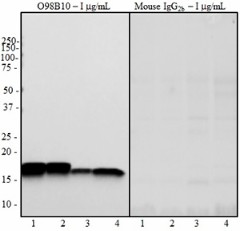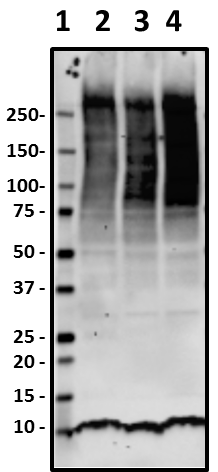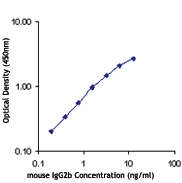- Clone
- O98B10 (See other available formats)
- Regulatory Status
- RUO
- Other Names
- Superoxide dismutase 1, Superoxide dismutase [Cu-Zn] , Superoxide Dismutase, Cystolic
- Isotype
- Mouse IgG2b, κ
- Ave. Rating
- Submit a Review
- Product Citations
- publications

-

Western blots of anti-SOD1 antibody (clone O98B10) and isotype-matched control mouse IgG2b. Lanes 1 and 2: 20 µg of normal human brain lysates; Lanes 3 and 4: 20 µg of mouse brain lysates. Blots were incubated overnight at 4°C with 1 µg/ml of primary antibodies, followed by incubation with horseradish peroxidase labeled goat anti-mouse IgG secondary antibody. Enhanced Chemiluminescence was used as the detection system. -

Western blot of purified anti-SOD1 antibody (clone O98B10). Lane 1: Molecular weight marker; Lane 2: 20 µg of Drosophila S2 (embryonic) cell lysate. The blot was incubated with 0.5 µg/mL of the primary antibody overnight at 4°C, followed by incubation with HRP-labeled goat anti-mouse IgG (Cat. No. 436302). Enhanced chemiluminescence was used as the detection system.
| Cat # | Size | Price | Save |
|---|---|---|---|
| 850701 | 25 µg | ¥23,320 | |
| 850702 | 100 µg | ¥58,300 |
Superoxide dismutase 1 (SOD1) is one of three isozymes responsible for destroying free superoxide radicals in the body. SOD1 is a homodimeric cytoplasmic Cu/Zn binding protein that converts harmful superoxide radicals to oxygen and hydrogen peroxide. The other isozymes are SOD2 and SOD3, which are localized to the mitochondria and extracellular space, respectively. SOD1 mutations are associated with familial amyotrophic lateral sclerosis.
Product DetailsProduct Details
- Verified Reactivity
- Human, Mouse, Rat, Drosophila
- Antibody Type
- Monoclonal
- Host Species
- Mouse
- Immunogen
- Full-length human SOD1 expressed in 293T cells transfected with human SOD1 expression vector.
- Formulation
- Phosphate-buffered solution, pH 7.2, containing 0.09% sodium azide.
- Preparation
- The antibody was purified by affinity chromatography.
- Concentration
- 0.5 mg/ml
- Storage & Handling
- The antibody solution should be stored undiluted between 2°C and 8°C.
- Application
-
WB - Quality tested
- Recommended Usage
-
Each lot of this antibody is quality control tested by Western blotting. For Western blotting, the suggested use of this reagent is 0.5 - 10 µg per ml. It is recommended that the reagent be titrated for optimal performance for each application.
- Application Notes
-
Reactivity to Drosophila was only verified with the purified format.
- Additional Product Notes
-
For Western blotting, the suggested use of this reagent is 1 - 5 µg/ml in human, mouse, and rat and 0.5 - 10 µg/ml in Drosophila.
- Product Citations
-
- RRID
-
AB_2716015 (BioLegend Cat. No. 850701)
AB_2716016 (BioLegend Cat. No. 850702)
Antigen Details
- Structure
- SOD1 is a homodimeric β-barrel protein that contains an intramolecular disulfide bond and a binuclear Cu/Zn site in each subunit. SOD1 monomers have an apparent molecular weight of ~16 kD.
- Distribution
-
Tissue sources: Ubiquitously expressed.
Cellular distribution: Cytosol, mitochondrion, peroxisome and nucleus. - Function
- SOD1 converts harmful superoxide radicals in the body to oxygen and hydrogen peroxide.
- Interaction
- UBC, CCS, PRDX1, HSPA4
- Biology Area
- Cell Biology, Neurodegeneration, Neuroscience, Protein Misfolding and Aggregation
- Molecular Family
- Enzymes and Regulators
- Antigen References
-
1. Lee S, Kim HJ. 2015. Exp. Neurobiol. 24(1):1-7.
2. Tafuri F, et al. 2015. Front Cell Neurosci. 9: 336.
3. Palomo, GM, Manfredi G. 2015. Brain Res. 1607:36-46.
4. Rosen DR, et al. 1993. Nature 362 (6415):59-62. - Gene ID
- 6647 View all products for this Gene ID
- UniProt
- View information about SOD1 on UniProt.org
Related Pages & Pathways
Pages
Related FAQs
Other Formats
View All SOD1 Reagents Request Custom Conjugation| Description | Clone | Applications |
|---|---|---|
| Purified anti-SOD1 | O98B10 | WB |
Customers Also Purchased



Compare Data Across All Formats
This data display is provided for general comparisons between formats.
Your actual data may vary due to variations in samples, target cells, instruments and their settings, staining conditions, and other factors.
If you need assistance with selecting the best format contact our expert technical support team.










Follow Us